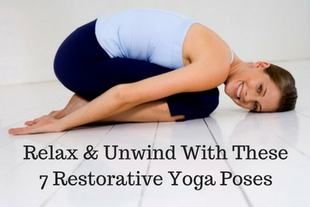
Disclosure: As an Amazon Associate I earn from qualifying purchases. This page may contain affiliate links, which means I may receive a commission if you click a link and purchase something that I have recommended. There is never an additional cost to you.
In our previous post “What is Restorative Yoga?” we went through the basics of Restorative Yoga. In this post “Relax & Unwind With These 7 Restorative Yoga Poses”, we want to show you some Restorative Yoga poses. All of these poses are really for beginners, so as always, please seek advice from your Doctor if you have any medical problems before starting your Restorative Yoga Poses journey.
Here are 7 Restorative Yoga Poses to get you started:
1. Legs Up The Wall Pose (Viparita Karani)
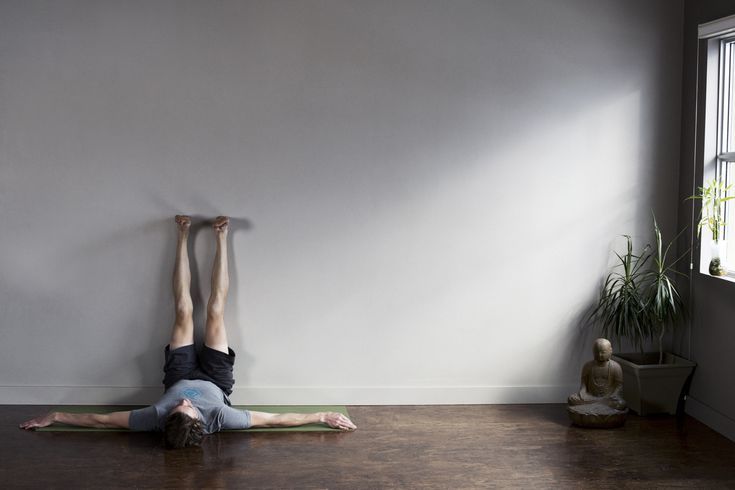
Legs Up the Wall is a rejuvenating inverted pose that brings relief to the spine, feet, legs, and nervous system. A clam, gentle way to bring the body into a state of deep relaxation and renewal. The Viparita Karani pose is recommended for all yoga students, no matter their level of experience. One of our favourite Restorative Yoga Poses!
How to do the Legs Up The Wall Pose:
- Set a bolster or firm, long pillow on the floor against the wall.
- Begin the pose by sitting with your left side against the wall. Your lower back should rest against the bolster, if you’re using one.
- Gently turn your body to the left and bring your legs up onto the wall. If you are using a bolster, shift your lower back onto the bolster before bringing your legs up the wall. Use your hands for balance as you shift your weight.
- Lie down by lowering your back to the floor. Rest your shoulders and head on the floor.
- Shift your weight from side-to-side and scoot your buttocks close to the wall. Let your arms rest open at your sides, palms facing up. If you’re using a bolster, your lower back should now be fully supported by it.
- Let the heads of your thigh bones (the part of the bone that connects in the hip socket) release and relax, dropping toward the back of your pelvis.
- Close your eyes. Hold for 5-10 minutes, breathing with awareness.
- To release, slowly push yourself away from the wall and slide your legs down to the right side. Use your hands to help press yourself back up into a seated position.
Benefits of the Legs Up The Wall Pose are:
- Alleviates headaches
- Boosts energy
- Soothes menstrual cramps (some yoga traditions advice against doing Viparita Karani during menstruation)
- Relieves lower-back pain
- Improves muscle fatigue
- Improves high and low blood pressure
- Helps with digestion problems
- Improves insomnia
2. Supported Bridge Pose (Setu Bandha Sarvangasana)
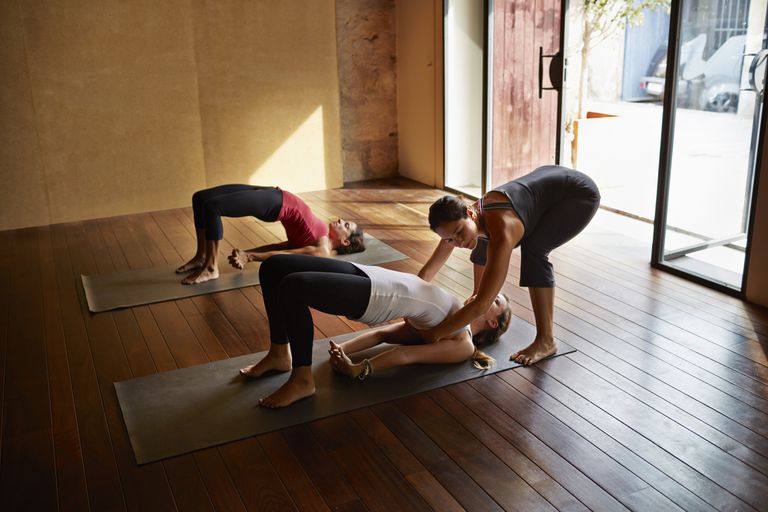
This works by using a supported block under your sacrum, which turns this yoga backbend into a restorative pose. Supported bridge pose is appropriate for beginners. The benefits are that it allows the spine to experience extension while being gently supported. It may can often help relieve back pain. Another favourite in our list of Restorative Yoga Poses.
How to do the Supported Bridge Pose:
- Lie on your back with your knees bent and the soles of your feet flat on the floor.
- Extend your arms on the floor with your finger reaching toward your heels, You should be able to just barely touch the backs of your heels with your fingertips.
- Your feet should be parallel. Maintain that position throughout the duration of the pose.
- Press down into the soles of your feet to lift your hips off the floor.
- Slide your yoga block under your back directly under your sacrum. Let your sacrum rest securely on the block. Your arms can stay outstretched on the floor next to your body.
- This should be a comfortable position. You may want to stay here several minutes as your body settles into the stretch and gets the benefits of a passive backbend. If the pose causes your back to hurt, remove the block and come down.
- To come out, press down into your feet and lift your hips again. Slide the block out from under your sacrum and gently lower your back to the floor.
Benefits of the Supported Bridge Pose are:
- opens the chest, heart, and shoulders.
- It stretches the spine, the back of the neck, the thighs, and the hip flexors (front hip joints).
- Because your heart is higher than your head in this pose, it is considered a mild inversion (less strenuous than other inversions, such as Headstand) and holds all the benefits of inversions:
- Relief from stress, fatigue, anxiety, headaches, insomnia, and mild depression.
- Calms the mind and is known to be therapeutic for individuals with high blood pressure.
- Because it opens the chest, it increases lung capacity, which is therapeutic for those with asthma.
3. Half Pigeon Pose (Eka Pada Rajakapotasana)
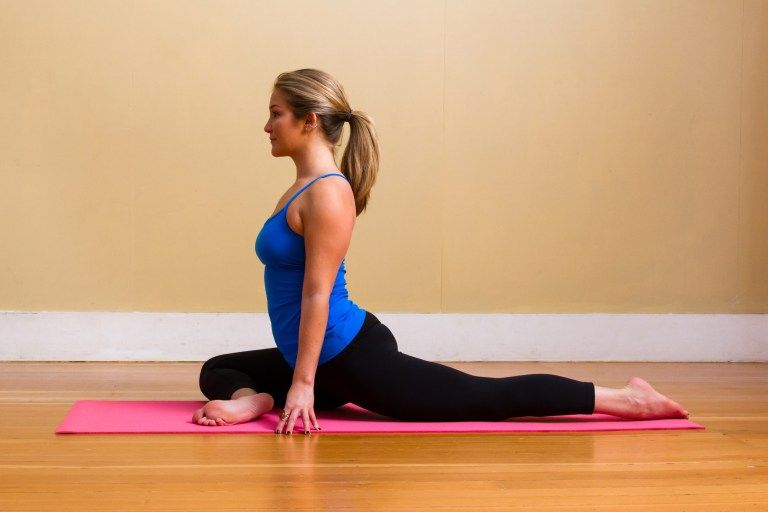
Half Pigeon is a yoga pose we all love to practice. Its dynamics are intense and liberating at the same time. Pigeon Pose can also be helpful in finding relief from sciatic and back pain as well as releasing built up stress, trauma, fear, and anxiety.
How to do the Half Pigeon Pose:
- Start from all fours (on hands and knees), bring your right knee forward and place it more or less behind your right wrist. Place your ankle somewhere in front of your left hip. The more your lower leg is parallel with the front of the mat, the more intense the hip opener.
- Slide your left leg back, straighten the knee and point the toes. Make sure your leg is behind your body and not drawing outwards and your heel is pointing up to the ceiling.
- Draw your legs in towards each other to help keep your hips square.
- Gently lower yourself down and use some support under your right buttock if needed, to keep your hips level.
- On an inhale lift your upper body, come on your fingertips, hands shoulder width apart, draw your navel in, tailbone down and open your chest.
- On an exhale walk your hands forward on the fingertips and lower your upper body to the floor. You can rest your forearms and forehead on the mat.
- Stay here for 5 breaths or longer and on an exhale try to release the tension in your right hip.
- Balance your weight on both legs.
- Come out of the pose by pushing back through the hands and lifting the hips, move the leg back into all fours.
Benefits of the Half Pigeon Pose are:
- Opens the hips.
- Uses core strength to keep your hips level.
- Calms your mind.
- Stretches the thighs and groins.
- Helps with urinary disorder
- Increases hip flexibility
- Improves posture, alignment and overall suppleness
- Diminishes lower back pain and stiffness
4. Reclined Bound Angle Pose (Supta Baddha Konasana)
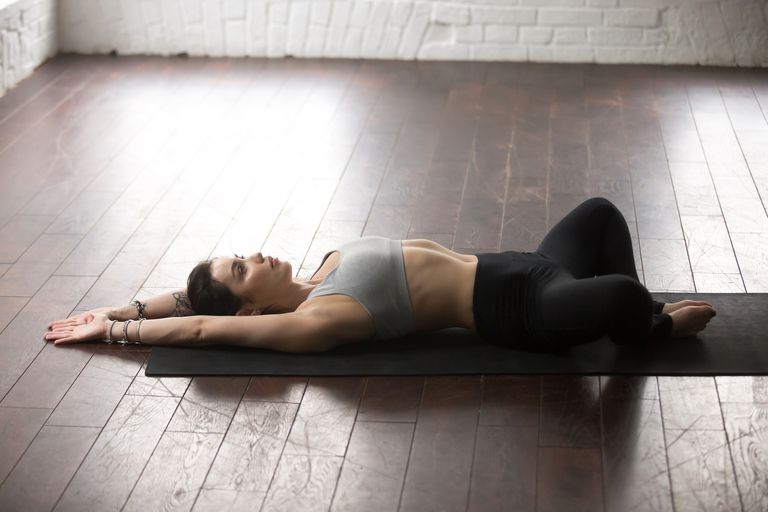
Reclined Bound Angle Pose, also known as Reclined Cobbler’s Pose, is a deeply relaxing yoga position that is recommended for students of all levels. Its Sanskrit name — “Supta Baddha Konasana” (SOOP-tah BAH-duh cone-AHS-uh-nuh) — comes from four words: No 4 in our list of Restorative Yoga Poses.
- “Supta” — meaning “reclining”
- “Baddha” — meaning “bound”
- “Kona” — meaning “angle”
- “Asana” — meaning “pose”
How to do the Reclined Bound Angle Pose:
- Begin seated with your legs extended in front of you on the mat. Bend your knees and draw your heels in toward your pelvis. Press the soles of your feet together and let your knees drop open to both sides. This is the Bound Angle Pose (Badda Konasana).
- Lean backward and bring your elbows to the floor. Then, lower your back all the way to the floor.
- Gently shift your buttocks from side to side, adjusting your position so your spine lengthens along the floor while maintaining the natural curve of the lower back.
- Draw your shoulder blades gently inward and let your arms relax with your palms facing up.
- Relax your buttocks and lengthen your tailbone toward your heels.
- Close your eyes. Let your awareness become fully internal.
- Let your breath occur naturally. Allow your body to feel heavy.
- Stay here for 1-10 minutes. To come out of the pose, draw your knees together. Then, roll to your right side and use your hands to press yourself up to a comfortable seated position.
Benefits of the Reclined Bound Angle Pose are:
- Lowered blood pressure
- A decreased heart rate
- Decreased muscle tension
- Reduced occurrence of headaches
- Relief from fatigue and insomnia
- Reduced nervous tension and stress
- Relief from anxiety and panic attacks
- Increased overall energy levels
- Encourages the relaxation of the abdominal muscles, which is soothing for intestinal conditions, such as irritable bowel syndrome (IBS); and for reproductive disorders, such as PMS and infertility.
- This pose stretches the groin and inner thigh muscles, improving blood flow to the pelvis.
- It opens the chest, allowing for deeper breathing and improved oxygen flow — this is particularly beneficial for those with asthma and heart disease.
- Supta Baddha Konasana also positively stimulates the digestive organs, and improves digestion and eliminatio
5. Supported Child’s Pose (Balasana)
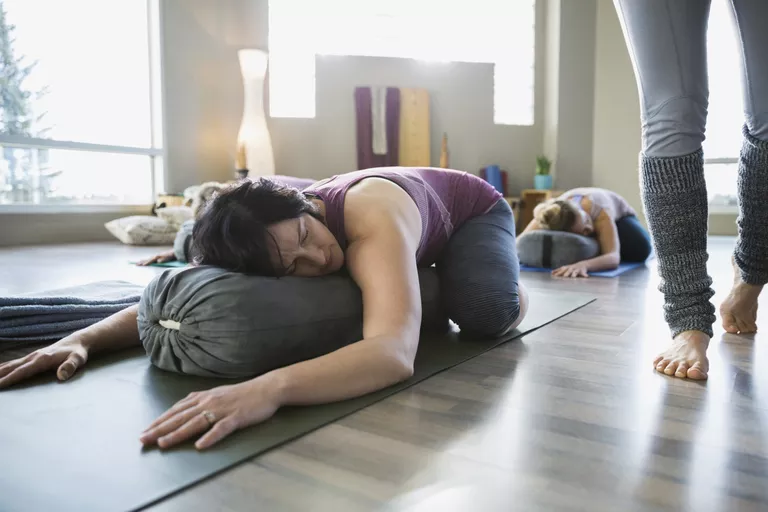
Balasana is a common beginner’s yoga pose. Quite often used as a resting position in between more difficult poses during a yoga practice. The word “Balasana” comes from the Sanskrit words “bala” (meaning “child”) and “asana” (meaning “pose”). A great favourite and never a doubt in our list of Restorative Yoga Poses.
- Slowly lower yourself so that both knees are on your yoga mat a little wider than your hips (if you need more padding, place a folded blanket beneath your knees). Your shins should be flat on the mat with your feet behind you, soles facing the ceiling.
- Now Sit on your heels.
- Place a bolster (pillow, couch cushion, or rolled blanket) lengthwise between your thighs; exhale and lay forward onto the bolster, turning your head sideways and let the bolster support the full weight of your head.
- Relax your arms to the ground, reaching forward a bit.
- Focus on your breath and close your eyes. As humans, we breathe approximately 22,000 times each day. Use this pose to help you find a deep connection with each breath.
- Midway through the pose, turn your head the other way so that your neck receives an even stretch.
Benefits of the Child’s Pose are:
- This pose helps soothe headaches as it relaxes upper back and neck.
- Calms the brain and helps relieve stress and fatigue.
- Relieves back and neck pain when done with head and torso supported.
- Great for weight loss when practiced regularly.
- Restores balance to the body.
6. Corpse Pose (Savasana)
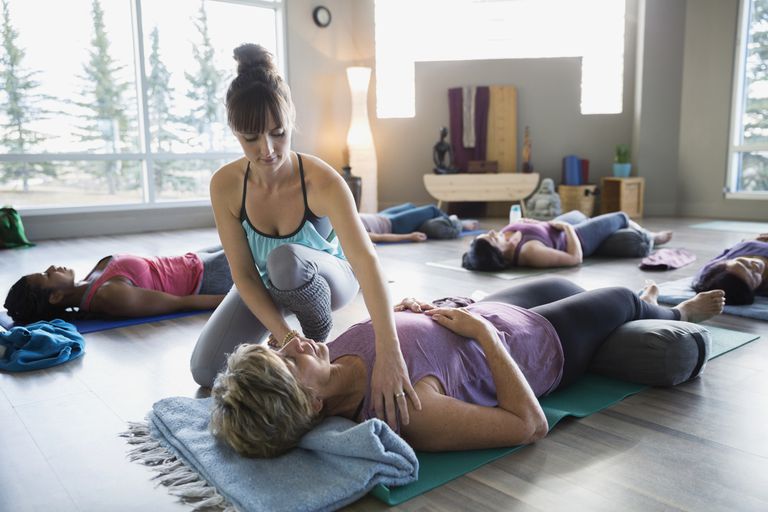
The Corpse Pose is usually practiced at the end of a long hard session, this reclining posture doesn’t always need props, but some people are more comfortable resting on a bolster with a pillow under the head. Take your time with this one – it’s extremely relaxing. One of the easiest but under-estimated Restorative Yoga Poses for beginners to undertake!
How to do the Corps Pose-
- Place a blanket lengthwise along the length of your sticky mat.
- Lie Down on your back and stretch the legs in Supta Tadasana. See that you are in the center of sticky mat.
Adjust the shoulders down your back as you did in Supta Padangustasana. - Allow your two feet to fall apart from one another, relaxing your leg muscles.
- Turn your upper arms from the inside out and place the arms equidistantly about 6 inches away from your body. The palms are turned up towards the ceiling.
- Relax every muscle in your body from the tip of your toes to the top of your head.
- Consciously relax the body and in so doing, quiet the mind and move into a deep relaxation for 15 minutes a day, if possible.
Benefits of the Corpse Pose are:
- Shavasana relaxes your whole body.
- Releases stress, fatigue, depression and tension.
- Improves concentration.
- Cures insomnia.
- Relaxes your muscles.
- Calms the mind and improves mental health.
- Excellent asana for stimulating blood circulation.
- Beneficial for those suffering from neurological problem, asthma, constipation, diabetes, indigestion.
- This posture brings a deep, meditative state of rest, which may help in the repair of tissues and cells, and in releasing stress. It also gives time for the yoga workout to sink in at a deeper level.
- This posture leaves you in a state of rejuvenation. It is the perfect way to end a yoga session, particularly if it has been a fast-paced one.
- It helps reduce blood pressure, anxiety, and insomnia.
- This is an excellent way to ground the body and reduce the Vata dosha(imbalance of the air element) in the body.
7. Seated Forward Bend (Paschimottanasana)
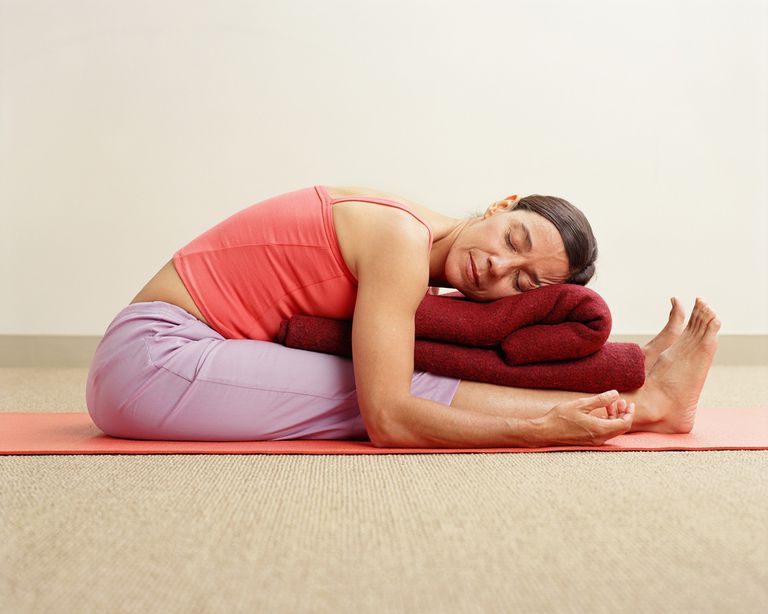
The Seated Forward Bend helps you stretch the hamstrings and the back. Never force the stretch – use pillows or bolsters to ease into the posture. As you build flexibility and knowledge of the posture, you’ll use the props less. Definitely a must for our list of Restorative Yoga Poses.
How to do the Sitting Forward Bend:
- Sit erect, with your legs, stretched out in front of you. Make sure that your toes are flexed towards you.
- Inhale and raise your arms over your head. Stretch.
- Exhale and bend forward. Feel the fold from your hip joints. Your chin should move towards your toes.
- Stretch out your arms, and let them reach the furthest they can, possibly till your toes. But make sure that you don’t stretch too far.
- Inhale. Then, lifting your head slightly, elongate your spine.
- Exhale and move your navel towards your knees.Repeat this a few times.
- Then, place your head on your legs, and hold the pose.
- Inhale and come up back to the sitting position with your arms stretched out.
Benefits of the Sitting Forward Bend are:
- Calms the brain and helps relieve stress and mild depression.
- Stretches the spine, shoulders, hamstrings.
- Stimulates the liver, kidneys, ovaries, and uterus.
- Improves digestion.
- Helps relieve the symptoms of menopause and menstrual discomfort.
- Soothes headache and anxiety and reduces fatigue.